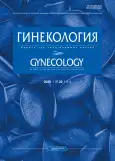The experience of using fesoterodine in patients with overactive bladder in the older age group
- 作者: Ermakova E.I.1
-
隶属关系:
- Kulakov National Medical Research Center for Obstetrics, Gynecology and Perinatology
- 期: 卷 22, 编号 1 (2020)
- 页面: 45-49
- 栏目: ORIGINAL ARTICLE
- URL: https://journal-vniispk.ru/2079-5831/article/view/33969
- DOI: https://doi.org/10.26442/20795696.2020.1.200067
- ID: 33969
如何引用文章
全文:
详细
Aim. To evaluate the effectiveness and tolerability of the drug fezoterodin in older patients with оveractive bladder (OAB).
Materials and methods. In 2019, 50 women with OAB aged 50 to 82 years (average age was 67.5±12.5 years) were treated in the framework of donation of the drug fezoterodin (Toviaz). The patients were divided into two groups: group 1 included 25 women had received treatment with fesoterodine dose of 4 mg per day for 12 weeks, group 2 consisted of 25 women, the fesoterodine dose to 8 mg per day for 12 weeks. The diagnosis of OAB was confirmed by a urodynamic study.
Results. 48 (96%) patients out of 50 completed a 12 week course of treatment. The efficacy and tolerability of the drug fezoterodin in both groups was 93.7%. Mild adverse events (dry mouth, constipation, blurred vision) were observed in 11 (22.9%) patients out of 48 treated. None of the women had cognitive impairment (memory impairment, decreased concentration, drowsiness, impaired thinking and orientation).
Conclusion. Our experience with M-cholinoblocator fezoterodin showed statistically and clinically significant improvements in all symptoms of OAB, as well as good tolerability of the drug in patients aged 50 to 82 years.
作者简介
Elena Ermakova
Kulakov National Medical Research Center for Obstetrics, Gynecology and Perinatology
编辑信件的主要联系方式.
Email: ermakova.health@mail.ru
Candidate of Medical Sciences
俄罗斯联邦, Moscow参考
- Yeo EK, Hashim H, Abrams P. New therapies in the treatment of overactive bladder. Expert Opin Emerg Drugs 2013; 18 (3): 319–37. doi: 10.1517/14728214.2013.823156
- Martina R, Kay R, Abrams P et al. A clinical perspective on the analysis and presentation of the number of incontinence episodes following treatment for OAB. Neurourol Urodyn 2016; 35 (6): 728–32. doi: 10.1002/nau.22787
- Milsom I, Abrams P, Cardozo L et al. How widespread are the symptoms of an overactive bladder and how are they managed? A population-based prevalence study. BJU Int 2001; 87 (9): 760–6.
- An F, Yang X, Wang YJ et al. OAB epidemiological survey of general gynaecology outpatients and its effects on patient quality of life. Neurourol Urodyn 2016; 35 (1): 29–35. doi: 10.1002/nau.22659
- Lin FY, Yang YC, Lin CL, Lee LJ. Increased risk of overactive bladder in patients with idiopathic Parkinson’s disease: Insight from a nationwide population-based cohort study. PLoS One 2018; 13 (3): e0193783. doi: 10.1371/journal.pone.0193783
- Mckellar K, Bellin E, Schoenbaum E et al. Treatment for Overactive Bladder in a Racially Diverse Population. Urology 2019; 126: 70–5. doi: 10.1016/j.urology.2018.12.021
- Zhu J, Hu X, Dong X, Li L. Associations Between Risk Factors and Overactive Bladder: A Meta-analysis. Female Pelvic Med Reconstr Surg 2019; 25 (3): 238–46. doi: 10.1097/SPV.0000000000000531
- Chae J, Yoo EH, Jeong Y et al. Risk factors and factors affecting the severity of overactive bladder symptoms in Korean women who use public health centers. Obstet Gynecol Sci 2018; 61 (3): 404–12. doi: 10.5468/ogs.2018.61.3.404
- Blomquist JL, Muñoz A, Carroll M, Handa VL. Association of Delivery Mode With Pelvic Floor Disorders After Childbirth. JAMA 2018; 320 (23): 2438–47. doi: 10.1001/jama.2018.18315
- Jackson S, James M, Abrams P. The effect of oestradiol on vaginal collagen metabolism in postmenopausal women with genuine stress incontinence. BJOG 2002; 109: 339–44.
- Chapple CR, Mironska E, Wagg A et al. Multicriteria Decision Analysis Applied to the Clinical Use of Pharmacotherapy for Overactive Bladder Symptom Complex. Eur Urol Focus 2019 Oct 15. pii: S2405-4569(19)30296-2. doi: 10.1016/j.euf.2019.09.020
- Khastgir J. Antimuscarinic drug therapy for overactive bladder syndrome in the elderly – are the concerns justified? Expert Opin Pharmacother 2019; 20 (7): 813–20. doi: 10.1080/14656566.2019.1574749
- Bientinesi R, Sacco E. Managing urinary incontinence in women – a review of new and emerging pharmacotherapy. Expert Opin Pharmacother 2018; 19 (18): 1989–97. doi: 10.1080/14656566.2018.1532502
- Kosilov K, Kuzina I, Kuznetsov V, Kosilova E. Influence of current state of executive function and working memory on adherence to antimuscarinic therapy in older women with OAB. Eur J Obstet Gynecol Reprod Biol X 2019; 4: 100086. doi: 10.1016/j.eurox.2019.100086
- Usmani SA, Reckenberg K, Johnson O et al. Relative Risk of Adverse Events and Treatment Discontinuations Between Older and Non-Older Adults Treated with Antimuscarinics for Overactive Bladder: A Systematic Review and Meta-Analysis. Drug Aging 2019; 36 (7): 639–45. doi: 10.1007/s40266-019-00674-9
- Gamé X, Peyronnet B, Cornu JN. Fesoterodine: Pharmacological properties and clinical implications. Eur J Pharmacol 2018; 833: 155–7. doi: 10.1016/j.ejphar.2018.05.036
- Minhas R, Tadrous M, Elterman D, Gomes T. Trends in the use of older overactive bladder agents and uptake of fesoterodine and mirabegron in Canada. Neurourol Urodyn 2018; 37 (5): 693–1700. doi: 10.1002/nau.23469
- Choi JB, Cho KJ, Park WH et al. Treatment Satisfaction with Flexible-dose Fesoterodine in Patients with Overactive Bladder who were Dissatisfied with Previous Anticholinergic Therapy: A Multicenter Single-Arm Clinical Study. Urol J 2019 Mar 18. doi: 10.22037/uj.v0i0.4650
- Goldman HB, Morrow JD, Gong J et al. Early onset of fesoterodine efficacy in subjects with overactive bladder. BJU Int 2011; 107 (4): 598–602. doi: 10.1111/j.1464-410X.2010.09586.x
- Van Kerrebroeck PE, Heesakkers J, Berriman S et al. Long-term safety, tolerability and efficacy of fesoterodine treatment in subjects with overactive bladder symptoms. Int J Clin Pract 2010; 64 (5): 584–93. doi: 10.1111/j.1742-1241.2010.02361.x
- Опросник для оценки симптомов гиперактивного мочевого пузыря. Русская версия: urocon.ru›web/doc/oab.pdf [Oprosnik dlia otsenki simptomov giperaktivnogo mochevogo puzyria. Russkaia versiia: urocon.ru›web/doc/oab.pdf (in Russian).]
- Oelke M. FORTA: система классификации для подбора препаратов, подходящих для пожилых людей; СНМП: симптомы нижних мочевыводящих путей; ГМП: гиперактивный мочевой пузырь. Age Aging 2015. doi: 10.1093/ageing/afv077 [Oelke M. FORTA: sistema klassifikatsii dlia podbora preparatov, podkhodiashchikh dlia pozhilykh liudei; SNMP: simptomy nizhnikh mochevyvodiashchikh putei; GMP: giperaktivnyi mochevoi puzyr’. Age Aging 2015. doi: 10.1093/ageing/afv077 (in Russian).]
补充文件







